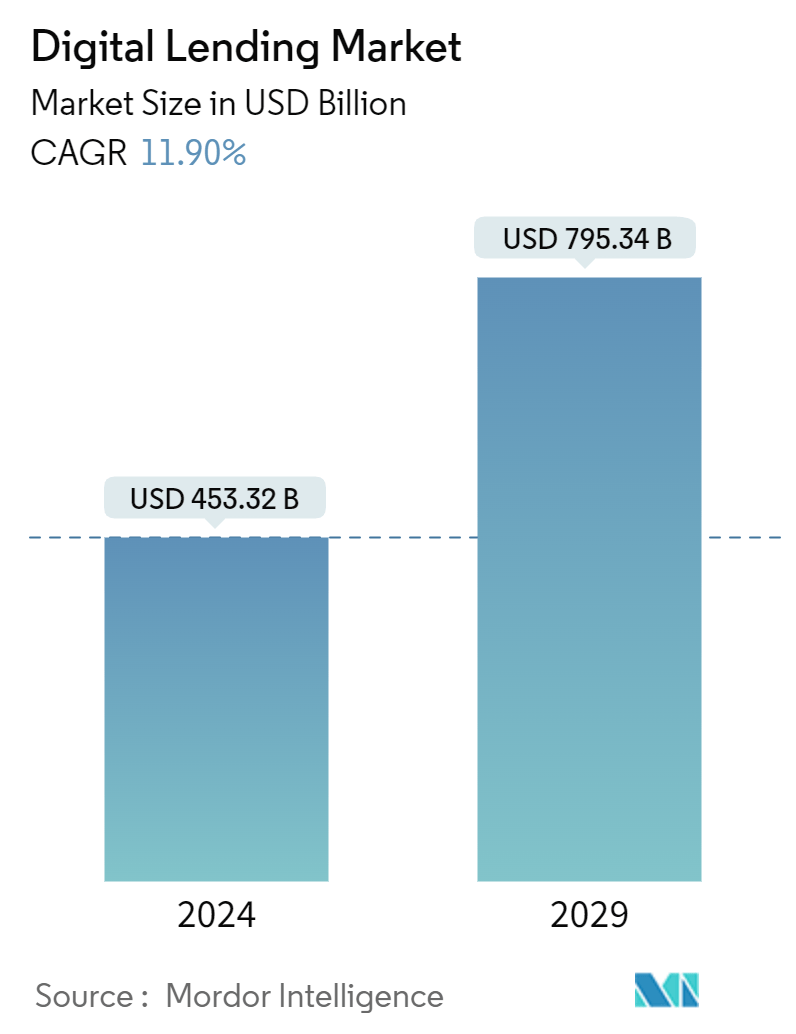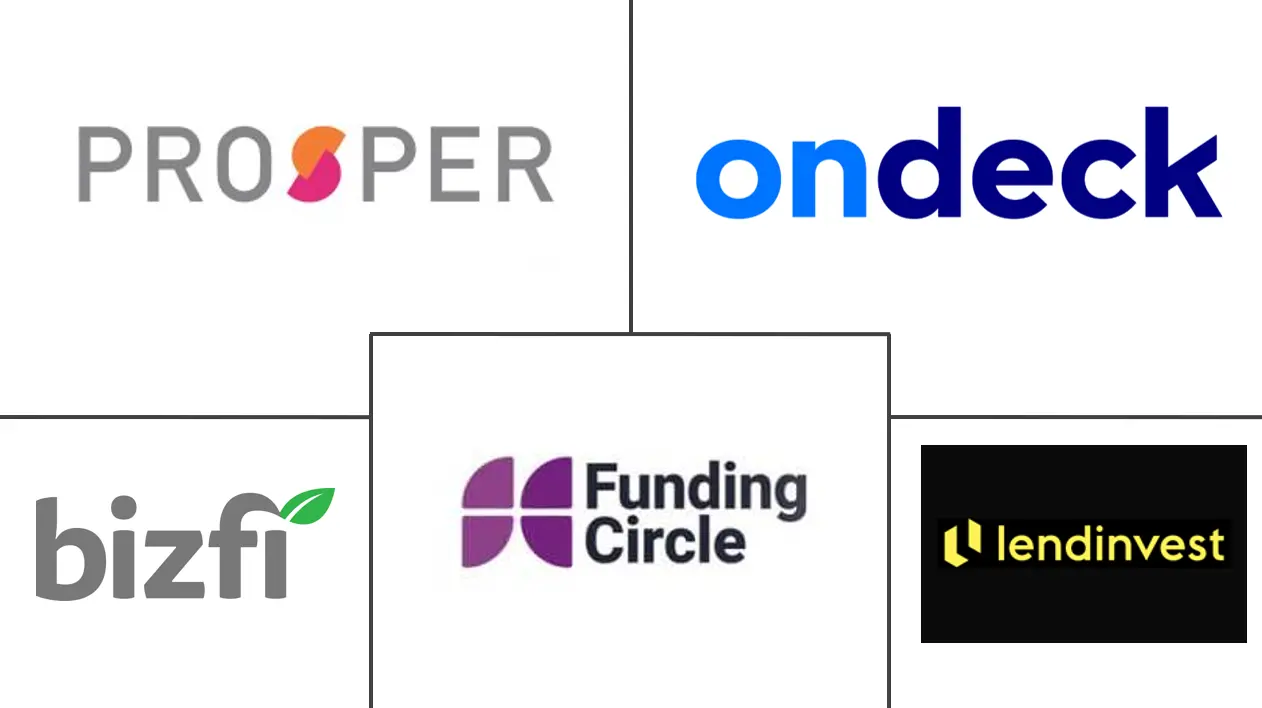Market Size of Digital Lending Industry

| Study Period | 2019 - 2029 |
| Market Size (2024) | USD 453.32 Billion |
| Market Size (2029) | USD 795.34 Billion |
| CAGR (2024 - 2029) | 11.90 % |
| Fastest Growing Market | Asia Pacific |
| Largest Market | North America |
Major Players
*Disclaimer: Major Players sorted in no particular order |
Digital Lending Market Analysis
The Digital Lending Market size is estimated at USD 453.32 billion in 2024, and is expected to reach USD 795.34 billion by 2029, growing at a CAGR of 11.90% during the forecast period (2024-2029).
- Digital lending, also known as fintech lending, involves securing loans through online platforms, making the borrowing process more efficient. Rather than physically visiting a bank, borrowers can apply for loans online. This digital approach removes the need for traditional intermediaries, such as banks, and significantly reduces the burden of paperwork.
- The lending landscape has changed drastically over the years due to the rapid adoption of digitization in the BFSI industry. While the traditional form of lending still prevails in many parts of the world, the benefits provided by digital solution providers are increasingly paving the way for the adoption of digital lending solutions and services across enterprises.
- Another major factor driving the market's growth is the changing consumer expectations and behavior due to the several benefits of digitizing banking and financial services. Customers may hail from diversified backgrounds and require loans for various purposes, ranging from personal loans to SME finance and home loans.
- Furthermore, technological advancements, such as the proliferation of smartphones, have led to an increase in the adoption of digital banking across several end-user verticals. Also, technologies like artificial intelligence, machine learning, and cloud computing benefit banks and fintech as they can process vast amounts of customer information. This data and information are then compared to obtain results about timely services/solutions that customers want, which has aided in developing customer relations.
- Aire, Kabbage, and Kasisto are some of the most prominent financial industry startups that are fully investing in AI. For instance, Kabbage uses AI algorithms that assess all risks of lending money to a particular customer, allowing company managers to give loans in minimal time. The demand for personalization of their needs among consumers in fintech and banking companies has further strengthened the demand for AI.
Digital Lending Industry Segmentation
Digital lending is a mix of traditional credit facilities from banks and NBFCs and innovative financing mechanisms in a digital lending platform, which is critical for the growth of the MSME industry. The study on digital lending includes coverage of the demand dynamics of online lending or alternative lending (non-bank) options available for both businesses and consumers.
The digital lending market is segmented by type (business and consumer) and geography (North America [United States and Canada], Europe [United Kingdom, Germany, France, and Rest of Europe], Asia-Pacific [China, India, Japan, and Rest of Asia-Pacific], and Rest of the World). The market sizes and forecasts are provided in terms of value (USD) for all the above segments.
| By Type | |||||
| |||||
|
| By Geography*** | |||||
| |||||
| |||||
| |||||
| Australia and New Zealand | |||||
| Latin America | |||||
| Middle East and Africa |
Digital Lending Market Size Summary
The digital lending market is experiencing significant transformation driven by the rapid adoption of digitization within the banking, financial services, and insurance (BFSI) sector. This shift is largely due to changing consumer expectations and the increasing demand for personalized financial services. Digital lending solutions are gaining traction as they offer numerous benefits over traditional lending methods, such as faster processing times and enhanced customer relations through the use of advanced technologies like artificial intelligence, machine learning, and cloud computing. The proliferation of smartphones and improved internet access have further facilitated the growth of digital banking, making it more accessible across various end-user verticals. Despite the dominance of traditional banking methods in many regions, the advantages of digital solutions are encouraging enterprises to adopt these innovative lending services.
The competitive landscape of the digital lending market is fragmented, with numerous solution providers vying for market share. Key players are focusing on innovation and strategic collaborations to enhance their offerings and expand their market presence. The market is also witnessing the emergence of new players who are leveraging technology to provide integrated solutions. Regulatory developments, such as those by the Reserve Bank of India, are shaping the market by addressing issues related to digital lending practices and promoting ethical standards. Additionally, the market is seeing a diversification of lending purposes, with startups expanding into areas like education and professional course financing. This evolution is supported by government initiatives and the growing trend towards cashless transactions in various countries, further propelling the adoption of digital lending solutions.
Digital Lending Market Size - Table of Contents
-
1. MARKET DYNAMICS
-
1.1 Market Drivers
-
1.1.1 Increasing Number of Potential Loan Purchasers with Digital Behavior
-
-
1.2 Market Challenges
-
1.2.1 Security concerns
-
-
-
2. MARKET SEGMENTATION
-
2.1 By Type
-
2.1.1 Business
-
2.1.1.1 Business Digital Lending Market Dynamics
-
2.1.1.2 Business Digital Lending Ecosystem (Including both Startups and Incumbents)
-
-
2.1.2 By Consumer
-
2.1.2.1 Consumer Digital Lending Market Dynamics
-
2.1.2.2 Consumer Digital Lending Models (Payday Lenders, Peer-to-Peer Loans, Personal Loans, Auto Loans, and Student Loans)
-
2.1.2.3 Consumer Digital Lending Ecosystem (Including both Startups and Incumbents)
-
-
-
2.2 By Geography***
-
2.2.1 North America
-
2.2.1.1 United States
-
2.2.1.2 Canada
-
-
2.2.2 Europe
-
2.2.2.1 United Kingdom
-
2.2.2.2 Germany
-
2.2.2.3 France
-
-
2.2.3 Asia
-
2.2.3.1 China
-
2.2.3.2 India
-
2.2.3.3 Japan
-
-
2.2.4 Australia and New Zealand
-
2.2.5 Latin America
-
2.2.6 Middle East and Africa
-
-
Digital Lending Market Size FAQs
How big is the Digital Lending Market?
The Digital Lending Market size is expected to reach USD 453.32 billion in 2024 and grow at a CAGR of 11.90% to reach USD 795.34 billion by 2029.
What is the current Digital Lending Market size?
In 2024, the Digital Lending Market size is expected to reach USD 453.32 billion.

